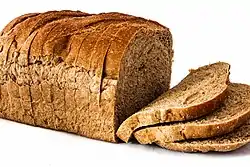 | |
| Type | Cake or quick bread |
|---|---|
| Place of origin | France |
| Region or state | Reims and Alsace |
| Associated cuisine | French cuisine |
| Main ingredients | |
| Ingredients generally used | |
| Similar dishes | |
Pain d'épices (French: [pɛ̃ depis]) or pain d'épice (French for 'spice bread') is a French cake or quick bread. Its ingredients, according to Le Dictionnaire de l'Académie française (1694), were "rye flour, honey and spices".[1] In Alsace, a considerable tradition incorporates a pinch of cinnamon.
Overview
According to Maguelonne Toussaint-Samat, the commercial production of pain d'épices was a specialty of Reims, based on a recipe of a pastry cook from Bourges and made popular when Charles VII and his mistress Agnes Sorel expressed their liking for it.[1] The honey used was the dark buckwheat honey of Brittany. In 1571, the Corporation of Spice Bread Makers of Reims were chartered separately from the party cooks; in 1596 the Parisian makers of pain d'épices were given their own charter. The Reims pain d'épices industry was decimated by World War I.[2] The pain d'épices of Dijon outpaced its older competitors in the Napoleonic era, and the bread is now considered one of the specialties of that city.
Pain d'épices was originally a sourdough bread without added leavening; it was left in a wooden trough to rest in a cool place for months, during which the honeyed rye flour experienced fermentation. When ready the dough was cooked in loaf moulds. The modern product usually rises with baking soda, or with baking powder, developed in the nineteenth century.
Because traditional pain d'épices is sweetened entirely with honey, honey merchants in France often stock loaves of it for sale. La Collective des Biscuits et Gâteaux de France reserves the name pain d'épices pur miel (French for 'pure honey spice bread') for pain d'épices sweetened only with honey.[3][4]
See also
References
- 1 2 Toussaint-Samat, Maguelonne (2009). A History of Food. Translated from French by Anthea Bell (2nd ed.). Chichester, West Sussex, United Kingdom: Wiley-Blackwell. pp. 28–30. ISBN 9781405181198.
- ↑ "Le pain d'épice de Dijon: l'histoire". Le Meilleur de Dijon (in French). Retrieved 19 February 2014.
- ↑ "Biscuits et gâteaux: Répertoire des dénominations et recueil des usages" (PDF) (in French). Les Biscuitiers de France. October 2001. Archived from the original (PDF) on 13 November 2008. Retrieved 19 February 2014.
L'appellation 'pain d'épices pur miel' est réservée au pain d'épices dans la composition duquel n'entre aucune autre matière sucrante que le miel.
- ↑ "Codes d'usage". Biscuits & Gâteaux de France (in French). La Collective des Biscuits & Gâteaux de France. Retrieved 19 February 2014.
